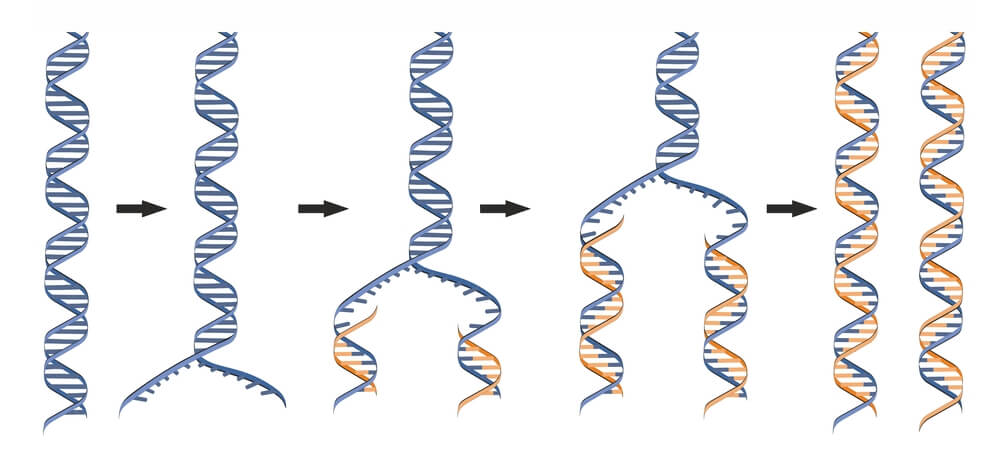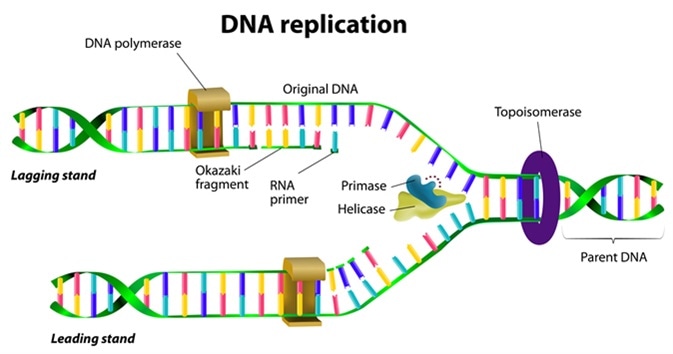After Dna Replication What Is the End Result
Replicating all of the DNA in a single human cell takes several hours of just pure copying time. During this process called replication termination DNA synthesis is completed the replication machinery is disassembled and daughter molecules are resolved.

Chapter 9 Dna Replication Chemistry
The continuously synthesized strand is called the leading strand since its elongation in the direction of replication fork movement exposes the template used for the synthesis of Okazaki fragments the lagging.

. Replication Enzymes DNA polymerase molecule. DNA replication finishes when converging replication forks meet. Each new DNA helix has one old strand with one new strand.
This is why DNA replication is described as semi-conservative half of the chain is part of the. What is the end result of DNA replication. Up to 24 cash back the DNA to unwind and separate.
Genome duplication is carried out by pairs of replication forks that assemble at origins of replication and then move in opposite directions. This produces a 3 overhang at one end and one end only of each daughter DNA strand such that the two daughter DNAs have their 3 overhangs at opposite ends. DNA ligase and DNA polymerase.
At the end of this process once the DNA is all replicated the cell actually has twice the amount of DNA that it needs and the cell can then divide and parcel this DNA into the daughter cell so that the daughter cell and the parental cell in many case are absolutely genetically identical. DNA replication Stage one. Two DNA molecules each both have two new strands.
What does DNA ligase do. A mRNA tRNA and rRNA molecules. Click to see full answer.
Two DNA molecules which each have one old strand and one new strand. The result of DNA replication is two DNA molecules consisting of one new and one old chain of nucleotides. This is why DNA replication is described as semi-conservative half of the chain is part of the original DNA molecule half is brand new.
The helix structure is unwound. What is the end result of translation. Once replication is completed the RNA primers are replaced by DNA nucleotides and the DNA is sealed with DNA ligase.
The final product of DNA replication is. DNA pol III then adds DNA nucleotides in the 5 to 3 direction until it. This is why DNA replication is described as semi-conservative half of the chain is part of the original DNA molecule half is brand new.
From this we get 3 different RNA molecules that are all involved in protein synthesis. In molecular biology DNA replication is the biological process of producing two identical replicas of DNA from one original DNA molecule. These small pieces of newly synthesized DNA called Okazaki fragments after their discoverer are joined by the action of DNA ligase forming an intact new DNA strand.
This is known as the end-replication problem. Then it attaches to the first DNA nucleotide of the template DNA chain. After several replication cycles this can result in lost information that could be critical for the individual to survive.
Telomeres are short repeating segments of DNA that are found at the end of each chromosome and do not. The result of DNA replication is two DNA molecules consisting of one new and one old chain of nucleotides. The ends of these chromosomes cannot be fully copied during replication resulting in a slow gradual shortening of the chromosome over subsequent replication cycles.
If this DNA isnt replicated then genetic material will be lost each time replication occurs. Begins adding complementary RNA mRNA nucleotides to the newly formed RNA molecule. Once completed the parent strand and its complementary DNA strand coils into the familiar double helix shape.
What is the result at the end of DNA replication. Thereof what happens after DNA replication. At the termination signal RNA polymerase releases DNA and RNA.
In the end replication produces two DNA molecules each with one strand from the parent molecule and one new strand. Special molecules break the weak hydrogen bonds between bases which are holding the two strands together. A new fragment begins with DNA polymerase III binding to the 3 end of the most recently produced RNA primer primer B in this case which is closest to the replication fork.
DNA replication occurs in all living organisms acting as the most essential part for biological inheritance. What 2 key proteins are involved in DNA replication. Click to see full answer.
Image result for What is the final result of DNA replication. In respect to this what is the end product of DNA replication. In DNA replication the product of translation is a polypeptide which will eventually become a fully functional protein.
This helps in the inheritance of certain characteristic features from the parents to their offspring which conveys that they are. After DNA replication each newly synthesized DNA strand is shorter at its 5 end than at the parental DNA strands 5 end. After the completion of the DNA replication each DNA has one parental or old strand and one daughter or new strand.
This is essential for cell division during growth and repair of damaged tissues while it also ensures that each of the new cells receives its own. This is because when DNA is being copied only one of the two new strands of DNA can be synthesized continuously in the 5 to 3 direction from the replication. Joins small fragments into a continuous chain.
The DNA is unwound and unzipped. To solve this issue telomeres are present in eukaryotes. In the end replication produces two DNA molecules each with one.
The result of DNA replication is two DNA molecules consisting of one new and one old chain of nucleotides.


Comments
Post a Comment